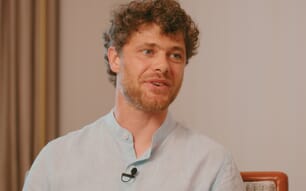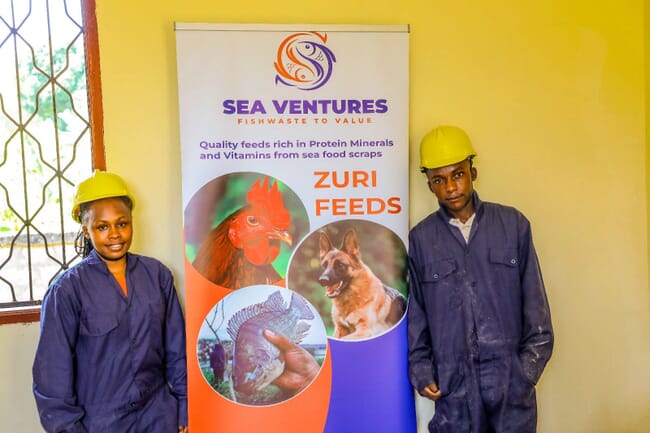
© Sea Ventures
Could you share a bit about your background and what inspired you to start using fish waste for feed?
My journey into sustainable feed production began with a foundation in marine biology and fisheries, which I studied in school. Working as an environmental consultancy associate in the fish industry exposed me to the significant waste generated during fish processing. Witnessing the environmental impact of discarded remains and post-harvest losses motivated me to explore innovative ways to recycle and prevent valuable resources from going to waste.
Sea Ventures officially commenced operations in 2022, initially developing a liquid protein supplement derived from fish waste for animal feeds. However, the process of transforming fish scraps into a consumable product proved challenging . After months of prototyping, refining, and overcoming hurdles, we achieved a breakthrough in November 2022. This marked a significant turning point, solidifying our steadfast commitment to repurposing fish waste.
How is the fish waste converted into animal feed?
The process starts with collecting and preserving fish waste, which is naturally highly perishable. Currently, our major suppliers are fishermen and fish processing companies due to the significant volume of waste they produce, but we also source from Beach Management Units (BMUs), women fish traders (known as 'mama karangas'), and fish vendors.
The waste is transported to our facility in Mombasa, where processing begins. Depending on the type of waste received, we either begin with drying or proceed directly to crushing followed by meticulous mixing and formulation. Our process includes pelletisation of the product, which is subsequently packaged, stored, and ultimately brought to market. On average, we collect between one to three tonnes of fish waste per week, with the flexibility to receive larger quantities when conditions permit. Close collaboration with fishermen, BMUs, and fish processing companies is maintained through a memorandum of understanding (MoU) that specifies the type of waste they supply.
How do you ensure the quality and nutritional value of the feeds that you produce?
We follow a standardised formulation process, adhering to the standards set by Kenya Bureau of Standards (KEBS), although we are not yet certified. The quality assurance begins with testing the fish waste for any potential harmful elements, including microbes. We conduct thorough analyses of the processed product to guarantee its safety and nutritional value. Our formulations are tailored to meet the specific standards required for each type of animal, whether it's fish, poultry, or pets.
There is significant demand especially for fish and chicken feeds. For fish feeds, Sea Ventures caters to tilapia and catfish, with growing orders for aquarium fishes. The current focus is on meeting the high demand for tilapia feeds due to prevalence of tilapia farming in our region. Notably, orders for prawns from coastal farmers near creeks are also on the rise. While we have pending orders for pet feeds, we are in the final stages of refining and testing before market release.
At present, our monthly production stands at approximately six tonnes per month, primarily focusing on fish and chicken feeds (three tonnes each).
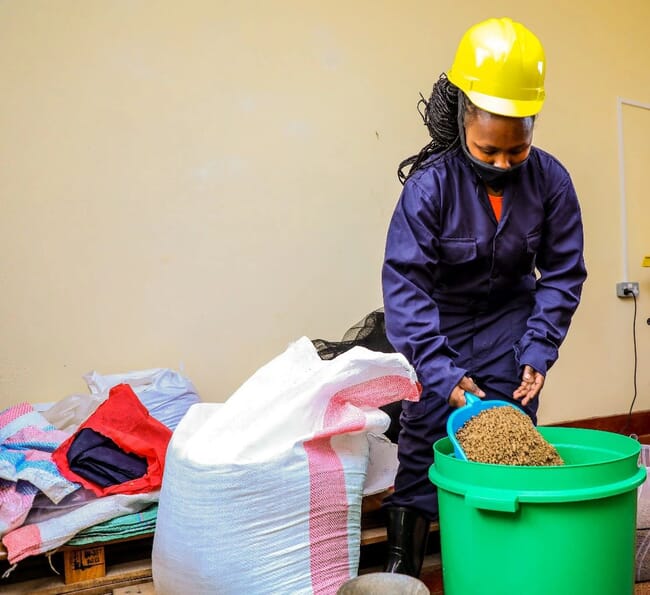
© Sea Ventures
Have you conducted any tests on the effectiveness of the feed for different species?
We consistently conduct tests during and after our processing stages. These tests are carried out at reputable institutions such Kenya Agricultural and Livestock Research Organisation (KALRO) in Naivasha, and in collaboration with the Kenya Marine Fisheries Research Institute (KMFRI) for in-depth analysis. While we are not yet certified by Kenya Bureau of Standards (KEBS), our commitment to rigorous testing ensures the effectiveness and safety of our feeds for various animals.
Are there any specific challenges that you face in adapting the feeds for different species?
One major hurdle is the rapid perishability of fish waste, making the collection and handling process complex. The lack of proper equipment for storage and drying exacerbates this issue. Despite these challenges, we are committed to maintaining high quality, utilising every part of the waste. Our approach aligns with a circular economy, repurposing what remains for organic manure or fertiliser.
Another significant challenge revolves around the scarcity and high cost of machinery for processing. The demand for our feeds is substantial, however, our inability to meet the market demand stems from the shortage of equipment. The entrepreneurial challenge of capital is also prevalent, as our project requires substantial investment in equipment and machinery. While we actively work to address these challenges, the high demand from the market remains a testament to the effectiveness and appeal of our products.
What feedback have you received from consumers regarding the performance of your feeds?
The response has been overwhelmingly positive, and the demand has surpassed our current supply capacity, presenting both a challenge and a motivating factor. Farmers appreciate the convenience of receiving a complete product rather than having to purchase and mix raw materials themselves. Notably, our feeds have proven cost-effective, offering a standardised nutrient level, unlike individual raw materials like omena and ochonga. The positive feedback, especially from long-standing customers, has been instrumental in fuelling our growth and commitment to sustainable agriculture.
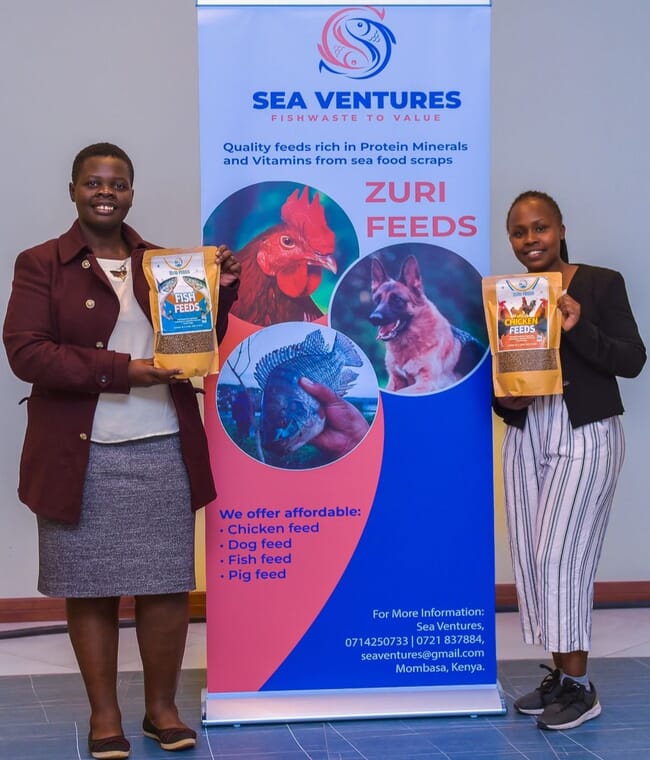
© Sea Ventures
How economically viable is your sustainable feed production, compared to conventional methods?
The economic viability of our method is a work in progress. While our approach of recycling and upcycling ingredients does contribute to reducing product costs, the lack of advanced machinery currently affects the overall pricing. As we invest in acquiring efficient machines and equipment, we anticipate a significant reduction in product prices. Our commitment to utilising recycled and upcycled materials aims to add value and streamline the production process, ultimately making our feeds more economically competitive in the long run.
Currently, our prices are comparable to those of conventional producers. However, we offer flexible pricing to actively engaged customers, such as regular buyers or those undergoing training with our team.
How did you raise your initial capital to start the business?
We began on a modest scale, relying on manual processes and personal savings, supplemented by grants obtained through competition pitching. We actively engaged with partners willing to support our project and participated in pitch competitions to secure additional grants.
Which organisations or individuals have you collaborated with at Sea Ventures?
I am not the sole force behind Sea Ventures; I share the journey with my silent partner and co-founder. We have collaborated with organisations such as Sote Hub for market linkages and training, Kenya Red Cross for women's social entrepreneurship training and grant support, and Kenya Climate Innovation Centre (KCIC) for potential support in acquiring advanced machinery.
Beyond that, Sea Ventures is actively involved in training local farmers in sustainable practices, including aquaculture and poultry farming. So far, we've trained 50 individuals; 30 have ventured into fish farming, whilst 20 have engaged with poultry farming. So far, 20 of the fish farmers have started group Mariculture farming. Our community involvement goes beyond fish waste – we also work with women in the collection and purchase of coconut husks, offering them an extra source of income.
Currently, Sea Ventures is working closely with around 15 fish farmers in Mombasa. But considering the many fish farmers in groups, we believe the total number of individuals involved in fish farming is much higher. Looking ahead, our goal is to expand and strengthen our community partnerships in the coming year to make an even more positive impact on local livelihoods. We plan to reach and help more fish farmers, aiming for a more accurate count by end of February 2024.

© Sea Ventures
Have you faced any regulatory challenges?
We have encountered some challenges at the county municipal level, but our engagement with regulatory bodies such as KEBS and the Kenya Fisheries Service (KeFS) has been cooperative. While we have not faced significant obstacles, obtaining licenses has become a priority due to recent legislative changes. The new animal feed processing act requires processors to acquire licenses starting from January 2024. To meet these standards, I pursued a feed formulation and milling technology course, ensuring compliance with the evolving regulatory landscape. Our interactions with regulatory bodies have been generally positive, and we are proactively adapting to the changing requirements.
As a woman in the field of sustainable feed production, have you encountered any specific gender-related challenges?
Being a woman in this field comes with its own set of challenges, particularly in Mombasa, where there's a prevailing belief in the superiority of men. I've faced skepticism and doubt, especially when given opportunities to speak or pitch before an audience. These challenges extend to personal and family spheres, where traditional gender roles have posed additional obstacles. Overcoming these biases and balancing the demands of business and family has been a significant learning curve.
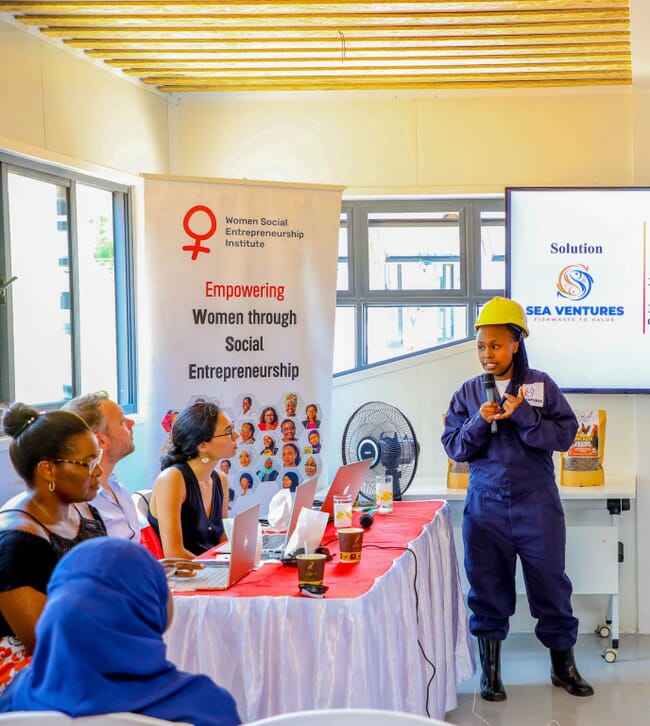
© Sea Ventures
What are your long-term goals for Sea Ventures initiatives?
First and foremost, we aim to maximise production to meet the demands of farmers and the market. Secondly, we are dedicated to creating employment opportunities, particularly for the youth and the local community. Our third goal involves the establishment of a larger processing plant and factory, with plans to employ over 2000 people in the community. Lastly, we are committed to reducing post-harvest losses among fishermen by expanding our fish waste upcycling efforts, ultimately improving livelihoods throughout the fisheries value chain.
What kind of support or partnerships are you seeking?
We are specifically looking for partnerships that involve the provision of machines, training support, and funding. Additionally, we are open to equity partnerships, although the terms would need careful consideration. We welcome collaborations that focus on training, especially in fish farming, and appreciate connections to individuals or entities already established in the field.

